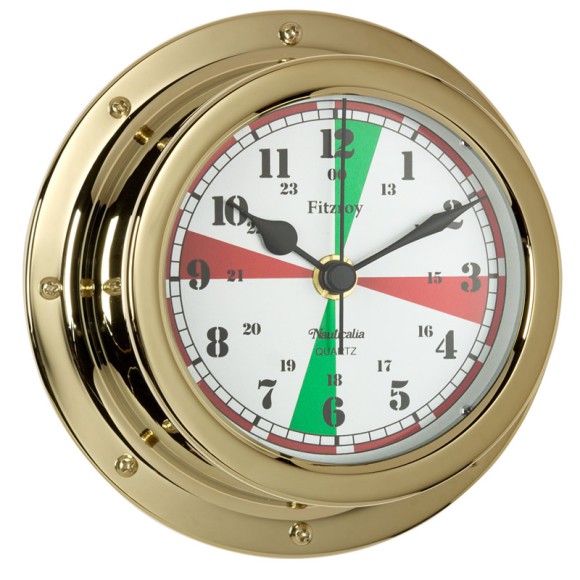Fitzroy Radio Silence Clock (QuickFix), Brass
Fitzroy Radio Silence Clock (QuickFix), Brass ~ Horloge Fitzroy Radio Silence (QuickFix), laiton ~ Orologio Fitzroy Silenzio Radio attacco/stacco rapido (QuickFix), Brass ~ Fitzroy Funkraumuhr mit Funkstillemarkierung, Messing ~ Reloj Fitzroy (sujeción rápida), Bronce ~ Fitzroy Radio Silence Clock (QuickFix), Brass
- Product Code: 6774
- Catalogue Page: 7
- Download high-res image
Our ranges of super durable, tarnish-free instruments have been coated with a newly developed protective coating using advanced surface treatment technology. This coating, far superior to lacquers and varnishes, can withstand more than 720 hours (the longest test period for this process) under NSS (Neutral Sea Salt) laboratory testing. NSS testing is a certificated and standardised test method used to check corrosion resistance of coatings on metals such as brass, zinc and steel. It is an accelerated corrosion test that produces a corrosive attack on the product coating from which the results can predict its suitability for use as a protective finish. These instruments will resist tarnishing even when exposed to the harsh marine environment for extended periods. Our "Fitzroy" range have Brass cases with super durable, tarnish-free coating and QuickFix fitting system. This unique QuickFix system allows the instrument to be locked hard to a bulkhead or wall but removed, in seconds, by hand. The instrument is supplied with a case plate which is screwed to the wall or bulkhead (instructions and drill hole template included). The instrument then simply slots over the base plate and with a gentle twist, is locked on. A reverse twist removes it again. This makes changing batteries easy, removal for storage easy, and avoids the tricky job of not scratching your polished case when screwing the instrument to the wall! QuickFix can also act to seal the instrument mechanism making it waterproof. In underwater tests, clocks fitted with the QuickFix waterproof system worked continuously at a depth of 300mm for more than 3 months. Radio Silence Zones
Tragically, the radio-signalling equipment carried by RMS Titanic was of little use, since the distress signals sent after hitting an iceberg in 1912 went unheard for several hours.
The disaster spurred an international review of maritime safety which made several recommendations, one of which led to the introduction of radio silence periods. These are three-minute periods immediately following each quarter hour reserved exclusively for making, and listening for, distress calls. The green sectors represent silence periods on the SSB (Single Side Band)) distress frequency of 2182kHz, as carried by commercial and some pleasure craft. The red sectors are for mores code distress signals on the 500kHz band, as used in radio telegraphy. Radio room clocks have traditionally been marked with the sectors as guidance for the operators. Case diameter 15cm, depth 4cm. Quartz clock movements use one AA battery.
| Attribute | |
| Brand | Nauticalia |
| Dimensions | 15cm |
| Material | Brass |







